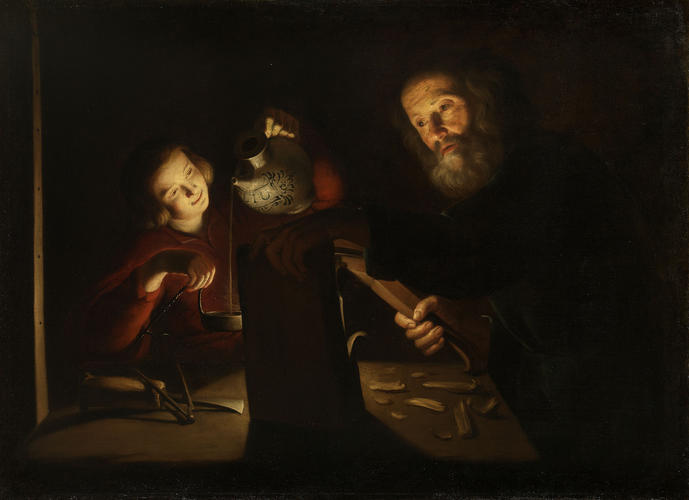-
1 of 253523 objects
Christ in the Carpenter's Shop c.1600-50
Oil on canvas | 99.0 x 135.8 cm (support, canvas/panel/stretcher external) | RCIN 404753
-
Bigot was a Provençal artist, the author of several signed altarpieces for Arles and Aix, who is documented in Rome between 1620 and 1634: he may also have been the creator of a coherent group of Caravaggesque scenes of which this is a fine example. None of this would have concerned the original royal purchaser, whether it was Frederick, Prince of Wales or his son George III, for the work is first recorded with an attribution in 1819 as 'G. della Notte. An Old Man and Boy by Lamplight … Very good'. Gherardo della Notte is the Italians' name for Gerard van Honthorst (1592–1656), who spent some years in Rome (1616–20) immediately before Bigot arrived. Both artists spent their Roman years looking at the work of Caravaggio.
In the seventeenth and eighteenth centuries Caravaggio wasn't generally popular. While writers of the day admired his realism, they hated his unvarnished ugliness and disapproved of his habit of masking bad drawing with dark shadows. However there was enough interest in Caravaggesque realism in this period for the work of slightly softer-edged followers to be collected. This painting is a good example of what in the eighteenth century would have been regarded as the acceptable face of Caravaggism, with an old, un-idealised face providing a contrast with a young and beautiful one and with everyday objects providing immediacy. Joseph is seen hacking at a piece of wood with a chisel, which conceals the flame of an oil lamp being filled by the Christ Child. In a way characteristic of Caravaggio, the story has been re-told in contemporary dress and was believed in 1819 to depict merely an 'Old Man and Boy'. Of course it is much more than this, as Bigot has made it seem that the Christ Child is the source of the light, not the hidden flame, reminding us that He is the 'Light of the World'.Provenance
Probably acquired by Frederick, Prince of Wales, or George III; first recorded without attribution in the Great Drawing Room, Kensington Palace in 1790
-
Creator(s)
-
Medium and techniques
Oil on canvas
Measurements
99.0 x 135.8 cm (support, canvas/panel/stretcher external)
114.7 x 149.5 x 8.0 cm (frame, external)
Alternative title(s)
A Carpenter and a Woman by Lamplight
Joseph and Mary by Lamplight
Joseph and Mary
